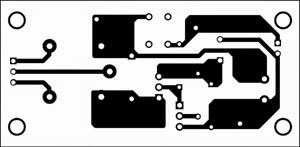This is the Simple Power-Saving Relay Driver Circuit Diagram.In many circuits, the switching action is performed by a relay, which in turn activates an external load. The power consumed by the relay may be unsuitable for battery-powered applications. Here is a simple solution using some inexpensive components to considerably save power.
Circuit and working
Fig. 1 shows circuit diagram of the power-saving relay driver where resistor R1 and transistor T1 form a standard relay driver circuit.
Once the relay is energised, its pole is pulled in to make contact with the N/O side, and it holds in that position with typically 75 per cent of its nominal-rated voltage. Power consumed by a relay coil during this holding time equals V²/R, where R is resistance of the relay coil and V is the voltage. Here resistors R2 and R3, transistor T2 and capacitor C1 lower the power consumption after actuation by applying less than the normal operating power.

Initially, when power is applied, capacitor C1 momentarily shorts resistor R2 and allows full voltage across the relay to pull the pole contact, and then slowly the current through the capacitor drops.
In the meantime, resistor R2 takes care of the current, ensuring it is just sufficient to hold the relay. The constant current mechanism formed by transistor T2 and resistors R2 and R3 effectively drives the relay at very less power.

Following calculations will help us understand how additional circuitry around relay driver transistor T1 saves power. Relay used here is a 12V, 400-ohm sugar-cube type. You can calculate the power saved as shown below:
Nominal current required for the relay (I)= 12V/400 ohm = 30mA
Power consumed by the relay=I2R=0.03A×0.03A×400 ohm =360mW
After introduction of the circuit:
Nominal current required for the relay (I)= 12V/400 ohm = 30mA
Power consumed by the relay=I2R=0.03A×0.03A×400 ohm =360mW
After introduction of the circuit:
The current through the coil (I) =VBE/R2=0.6V/47 ohm=12mA
Power consumed by the overall circuit = V×I = 12×0.012=144mW
Power saved=360mW-144mW=216mW
So, we conclude that considerable power can be saved using the additional circuitry.
This makes it fairly simple for anyone to re-design a relay driver to reduce its power consumption without the use of any expensive components.
An actual-size, single-side PCB for the power-saving relay driver is shown in Fig. 2 and its component layout in Fig. 3.
Switch S1 is used to test the relay driver circuit. You can connect the output of a control circuit, such as a micro controller, to CON2 for controlling the relay circuit.
CON3 helps in connecting to the electrical load. You can connect the load between N/O and pole contacts or N/C and pole contacts.

Fig. 2: An actual-size, single-side PCB for the power-saving relay driver

Fig. 3: Component layout for the PCB
Before connecting the load to CON3, verify the test point voltages given in the table. You
may reduce the value of R1 as per your requirement.
may reduce the value of R1 as per your requirement.
Sourced By: EFY Author: T.A. Babu













Having read this I thought it was really enlightening. I appreciate you finding the time and energy to put this article together.
ReplyDeleteI once again find myself personally spending way too much time both reading and commenting.
But so what, it was still worthwhile!
my weblog power reduction
Thanks Anonymous for your complements :)
DeleteHello! I know this is kinda off topic but I'd
ReplyDeletefigured I'd ask. Would you be interested in trading links or maybe
guest authoring a blog article or vice-versa?
My blog covers a lot of the same topics as yours
and I believe we could greatly benefit from each other. If you are interested feel
free to send me an email. I look forward to hearing from you!
Superb blog by the way!
Look at my webpage :: pc power saving
Thanks Anonymous.. sorry i don't know your name, and i said to you next time when ever you want to comment please login with your real name. and if you want for any together work . Contact us through proper channel. Thanks
Delete